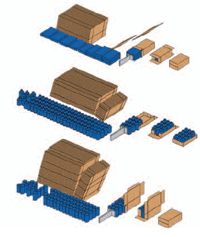 The final stretch of your manufacturing process, where your products are packed and readied to ship to your customers/clients wherever they may be, is often a huge part of any manufacturer’s operational expenses.
The final stretch of your manufacturing process, where your products are packed and readied to ship to your customers/clients wherever they may be, is often a huge part of any manufacturer’s operational expenses.
- Be packed securely so that they don’t get damaged or lost during shipment (which can mean hefty material expenses).
- Be prepped for shipment quickly to maximize the number of shipments you can ready each day.
These two goals are often at odds with one another, especially when relying primarily on manual labor to get the job done.
With manual labor, heavier packaging takes a longer time to apply, but faster manual packing methods might not provide sufficient protection for cross-country or overseas shipping. So, what’s the best way to optimize your end of line process, then?
What’s the best way to balance product protection with packing speed to benefit your business?
The answer might lie in the use of end of line automation solutions.
End of Line Automation and Material Efficiency
When you’re palletizing your products for bulk shipments to clients, packing material costs can take a significant chunk out of your margins.
Take shrink wrapping of pallets, for example. In this production process, the tighter the wrap, the more secure the contents are. The film can protect packages from becoming separated during shipping, moisture intrusion, impacts with loose objects, and punctures.
However, manual wrapping methods typically only stretch the material about 10 or 20%. Automated stretch wrapping machines, on the other hand, can stretch the film much further, easily achieving 250% or more stretch of the film during application.
What does this mean? The automated machine can stretch film much tighter than manual methods, providing superior protection. On top of that, the automated machine provides a significant savings on stretch film. For example, if you have 1,000 feet of material, a manual wrapping method would allow you to cover up to 1,200 feet, while automated stretch wrapping would allow you to cover 2,500 feet before running out.
Imagine only having to order half as much stretch film to cover your pallets.
End of Line Automation and Time Savings
The process of loading shipping containers or crates and then palletizing them is slow and full of potential risks to workers when done purely with manual methods.
Workers get tired and worn-out over the course of an eight-hour shift. Muscles get sore and strained after so much repetitive motion packing and moving slotted cases and crates. After hours and hours of hard labor, workers slow down as the strain takes its toll.
Strained, tired workers are more likely to look for shortcuts, and be less able to respond effectively to a sudden emergency. This increases the risk of time-lost safety incidents which bring your production to a grinding halt.
End of line automation not only speeds up the packing process, it can help to prevent the occurrence of safety incidents by limiting the amount of strenuous physical labor employees need to perform on a daily basis. This saves you time lost on addressing a factory floor emergency, workman’s comp claims, and expenses spent on recruiting and training new personnel to replace an injured worker.
In short, investing in factory automation can be the best way to optimize your end of line processes.
What kind of end of line automation is the best for your company? The answer to that will depend on many different factors, such as the type(s) of products you’re shipping and the number of products that your factory produces per minute.
If your factory has a relatively low product output per minute, then you’ll probably only need semi-automated equipment or very basic automation equipment such as a drop case packing system. If your product output is especially high, then you’ll most likely want to acquire heavily-customized, high-capacity automation tools, such as a side load case packing system.
Discover the benefits of using end of line automation tools for yourself today!




